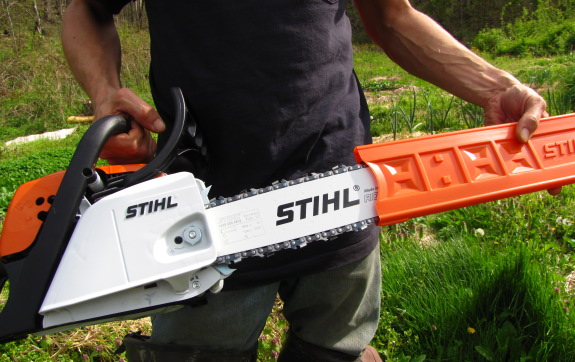
Chainsaw adjustment notes
Have you thought about
doing a series on maintaining chainsaws? Sharpening, cleaning, and
adjusting?
I would be really interested in that!
Eric in Japan
Thanks for the question Eric.
I've been learning as I go,
so I'm not sure if I've got enough experience to do a series on the
subject, but I might have enough information to form a short trilogy of
tips.
Chain adjustment: I learned
the hard way to never over tighten the nuts that secure down the chain
tension. The old 039 had a problem vibrating loose,
which would make me stop every so often and adjust the chain slack. My
amateur mistake was to tighten it too much, which stripped out the bolt
and required a trip to the shop to fix.
Stay tuned tomorrow for my
two cents on sharpening the chain with a file.
Want more in-depth information? Browse through our books.
Or explore more posts by date or by subject.
About us: Anna Hess and Mark Hamilton spent over a decade living self-sufficiently in the mountains of Virginia before moving north to start over from scratch in the foothills of Ohio. They've experimented with permaculture, no-till gardening, trailersteading, home-based microbusinesses and much more, writing about their adventures in both blogs and books.
Want to be notified when new comments are posted on this page? Click on the RSS button after you add a comment to subscribe to the comment feed, or simply check the box beside "email replies to me" while writing your comment.


If you don't want bolts or nuts to loosen without overtightening them you can use thread locker (from e.g. loctite). So-called nyloc nuts (with a nylon friction ring) also work well but can as a rule only be re-used a couple of times. Castellated nuts in combination with a cotter pin or drilled bolts fastened with safety wire also work fine.
In any case, make sure that there is no oil or grease on the bolt or nut's thread when you tighten it. It will decrease friction and can make you over-tighten the bolt. Anti-seize compound (sometimes called copper grease even though it's not technically a grease) is usually fine.
The best way to tighten a bolt repeatably is to tighten it manually until the joint has no play. Then using a spanner rotate it a set amount, e.g. 3/4 turn. How much you need to turn it depends on the diameter of the bolt, the free length and the required tension.
A lot of manuals use torque (because it is easy to measure) as a measure of bolt tension, but since this depends to a large degree on the coefficient of friction between the bolt and the threaded hole, it is not always reliable.
Roland --- Great info, as usual! Mark was talking about torque wrenches as he washed the dishes, but it sounds like they're not all they're cracked up to be. Your method makes a lot of sense.
Eric -- Glad it helped!
When checking chain tension, grasp the chain between two fingers and lift up. If the bottom of the drive link clears the bar, the chain is too loose. Another way to look at it is to not have any sag in the chain.
If the chain has stretched so much that the tensioner will not maintain tension, time for another chain.